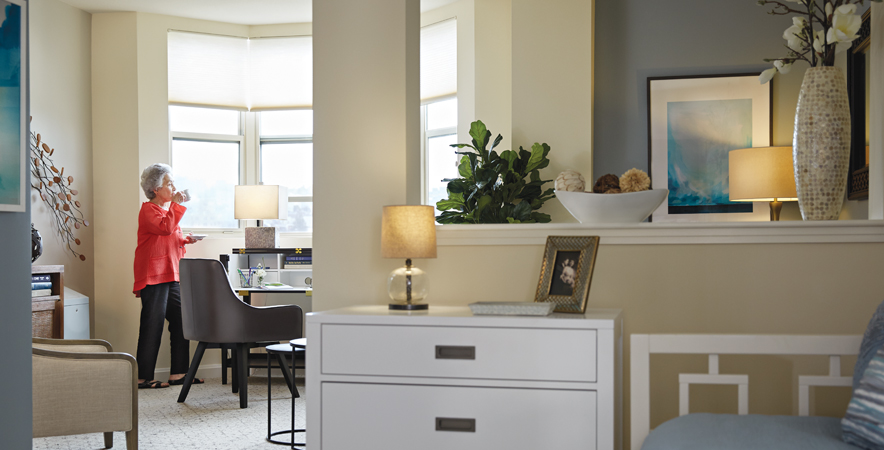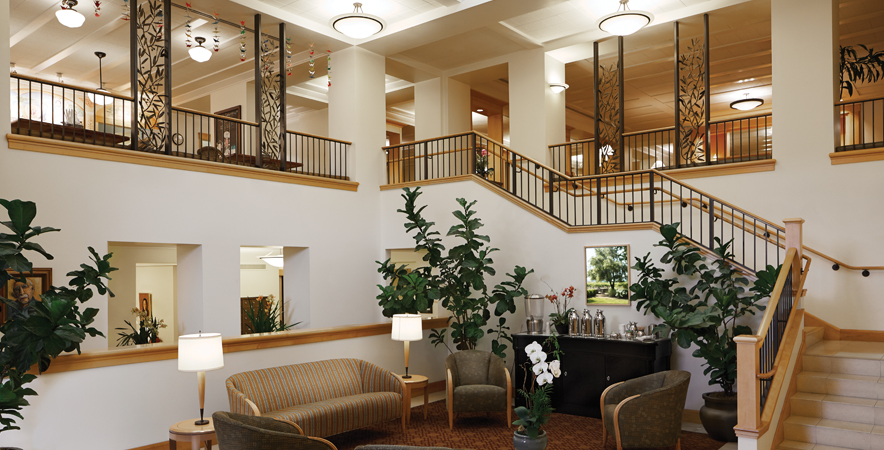Deciding on the right care for yourself or an aging family member can be a challenging journey. When the time comes to consider extra support, many families find themselves weighing the options of assisted living and home care. Both of these paths strive to help seniors maintain their independence while providing the care they need. The best choice is a very personal one, dependent on individual needs, preferences, and unique circumstances.
At Rhoda Goldman Plaza, a leading assisted living and memory care community in the heart of San Francisco, we understand the importance of making an informed decision, and we’re here to guide you through this process.
Assisted Living VS Home Care Audio Podcast – 16 Minutes 55 Seconds
What is Assisted Living?
Assisted living is a long-term housing option designed for older adults who need help with daily tasks but do not require the level of medical care provided in a nursing home. It’s a supportive environment that aims to help seniors maintain their independence while ensuring their safety and well-being. Assisted living communities, like ours at Rhoda Godman Plaza, offer a blend of housing, personalized care, and social opportunities, making it a suitable option for those who may find living alone increasingly challenging. Assisted living facilities provide a community setting where residents can receive help with activities of daily living (ADLs) and other services while still enjoying a sense of autonomy.

Key Aspects of Assisted Living:
- Setting: Assisted living occurs in a dedicated facility, sometimes referred to as a residential care facility, adult care home, or retirement home. These facilities can range from small buildings with a few residents to larger, more luxurious settings. They typically offer private or shared rooms, sometimes with small kitchenettes.
- Services: Assisted living communities provide a range of services to support residents’ needs. These generally include:
- Meals: Regular meals, often in a communal dining setting, with accommodations for dietary needs.
- Housekeeping: Assistance with cleaning and maintenance of living spaces.
- Laundry: Laundry services are typically provided for residents.
- Medication Management: Assistance with medication reminders and administration.
- Personal Care: Support with activities of daily living such as bathing, dressing, and grooming.
- Transportation: Transportation services for appointments, shopping, and social activities are often provided.
- Social and Recreational Activities: Many facilities offer planned social events, fitness programs, classes, and outings to encourage community engagement.
- Levels of Care: Assisted living facilities often offer different levels of care to meet the varying needs of their residents. These levels are typically based on the amount of assistance required with Activities of Daily Living (ADLs).
- Level One (Lowest Care): Suitable for seniors who are mostly independent but need some reminders for medications and appointments, or supervision when checking blood sugar or taking injections.
- Level Two (Moderate Care): For seniors needing assistance with one ADL, such as bathing or dressing, along with medication management.
- Level Three (Highest Care): Designed for seniors who require assistance with multiple ADLs, like bathing, dressing, getting around, and using the restroom, plus medication management.
- Staffing: Facilities usually have staff available 24/7 to assist residents with their needs. The staff-to-resident ratio is an important factor when choosing a facility. Some facilities may have registered nurses on staff, while others may not, so it’s important to know the facility’s protocol for emergencies.
- Cost: The cost of assisted living can vary widely depending on factors such as location, room size, and the level of care needed. The median monthly cost of assisted living was $5,551 in 2024. Prices typically range from $5,000 to $9,000 per month, but some areas can exceed this range. The annual median cost for a one-bedroom unit in an assisted living facility was $64,200 in 2023. These costs generally cover room, meals, and basic amenities, with extra fees for add-on services.

Pros and Cons of Assisted Living:
| Pros | Cons |
| Assistance with Daily Tasks: Support with bathing, dressing, and meals | Cost: Can be expensive, particularly in high-cost areas. Medicare does not cover assisted living. |
| Social Engagement: Opportunities to interact with peers and participate in social activities. | Less Privacy: May offer less privacy compared to living at home. |
| Maintenance-Free Living: No need to worry about household chores and home maintenance. | Medical Care: May not provide the level of medical care needed for some individuals. |
| Personalized Assistance: Care tailored to individual needs and preferences. | Leaving Home: Requires moving from one’s home, which can be a difficult transition. |
| Safety Features: Facilities are designed with safety features, including staff available 24/7 and emergency call systems. | Potential for Inflexibility: May have set schedules and rules that don’t align with everyone’s preferences. |
| Easier Access to Medical Care: Often located close to hospitals and other medical facilities and may have nurses on staff. | Potential for Lack of Personalization: Though care is tailored, it may not be as flexible as in-home care. |
| Mental Stimulation: Facilities offer activities to keep residents mentally active | Can feel less independent because you must rely on staff for help |
| Peace of mind for families: Knowing their loved ones are in a safe and secure environment with professional care. |

What is Home Care?
Home care, also known as in-home care or senior home care, is a wide range of support services that allow seniors to receive care in their own homes. This option enables individuals to maintain their independence while receiving the help they need with daily tasks and activities. It is a personalized approach that focuses on helping seniors age in place, in the comfort and familiarity of their own residences. Home care services are designed to meet a variety of needs and can range from basic assistance with daily activities to more complex medical care, depending on the individual’s requirements and preferences.
Key Aspects of Home Care:
- Setting: Home care takes place in the individual’s own home, which allows seniors to remain in a familiar and comfortable environment. This can be a significant benefit for those who have strong attachments to their homes and communities.
- Services: Home care services are highly customizable and can include:
- Assistance with Activities of Daily Living (ADLs): This includes help with personal hygiene, dressing, bathing, eating, and using the restroom.
- Help with Instrumental Activities of Daily Living (IADLs): This includes help with meal preparation, grocery shopping, laundry, light cleaning, and errands.
- Medication Management: Reminders and assistance with taking medications correctly.
- Companionship: Social interaction, conversation, and emotional support to prevent loneliness and isolation.
- Transportation: Assistance with transportation to appointments, errands, and social events.
- Skilled Medical Care: Some home care services may include physical therapy, wound care, and other specialized medical services, often provided by licensed professionals.
- Monitoring Vitals: Caregivers can monitor a senior’s vital signs, such as blood pressure and heart rate.
- Types of Caregivers: Home care is provided by various professionals, each with different qualifications and specialties:
- Home Care Aides: These are non-medical paraprofessionals who assist with ADLs and IADLs, provide companionship, and offer supervision.
- Home Health Aides (HHAs): Licensed medical professionals who can provide skilled nursing care, medication assistance, wound care, and rehabilitation services.
- Personal Care Attendants, Homemakers, and Companions: Provide assistance with cooking, shopping, bathing, laundry, and companionship.
- Flexibility: Home care can be provided on a part-time or full-time basis and can be adjusted to meet the changing needs of the individual. Services can be scheduled for a few hours a day, or 24/7 care can be arranged.
- Cost: The cost of home care can vary widely, depending on the services needed and the hours of care required. Part-time care is generally less expensive, but full-time care can be more costly than assisted living. The median hourly cost is about $24, but can reach up to $40 per hour. Home health aides cost an average of $6,481 per month for 40+ hours of care, and 24/7 care can add up to $200,000 or more per year. Costs are affected by insurance, location, and veteran’s benefits.

Pros and Cons of Home Care
| Pros | Cons |
| Personalized Care: One-on-one attention tailored to the individual’s specific needs and preferences. | Inconsistent Caregivers: Caregivers may change, making it difficult to establish a consistent routine and relationship. |
| Familiar Environment: Allows seniors to remain in their own homes, which can provide comfort and security. | Risk of Isolation: Especially for seniors who live alone and have limited social interaction. |
| Independence: Seniors retain more control over their daily lives and routines. | Safety Risks: May be present when the individual is alone, even with emergency alarms. |
| Flexibility: Care schedules can be adjusted to meet changing needs. | Caregiver Compatibility: It may take time to find a caregiver who is a good fit for the individual. |
| Pet Ownership: Allows seniors to keep their pets at home. | May not provide adequate medical care: unless a skilled professional is hired. |
| Potentially More Cost-Effective: Can be more affordable than assisted living for part-time care or those with limited needs. | Can be more expensive than assisted living for 24/7 care. |
| Companionship: Provides social interaction and emotional support and helps prevent loneliness. | Requires more effort from the family to manage and coordinate care. |
Comparing Assisted Living vs Home Care
Assisted living and home care are both designed to help seniors maintain their independence and quality of life while receiving necessary support, but they do so in different ways. Assisted living provides care within a residential facility, while home care delivers services within the senior’s own home. The best option for an individual depends on their unique needs, preferences, and financial situation.
Key Differences in Setting and Environment
- Assisted Living: Seniors move into a community setting, often referred to as a residential care facility, adult care home, or retirement home. This provides a structured environment with shared spaces and opportunities for social interaction with other residents.
- Home Care: Seniors receive care in the comfort of their own homes, allowing them to stay in a familiar environment and maintain a sense of independence and control over their surroundings.

Services Offered
Both assisted living and home care provide a range of services designed to assist seniors with their daily needs, but they may vary in terms of structure and availability:
- Assisted Living: Typically offers a comprehensive package of services, including meals, housekeeping, laundry, medication management, personal care, transportation, and social activities. The level of care is generally determined by an assessment prior to moving in, and it can be adjusted as needs change.
- Home Care: Offers more personalized services based on the specific needs of the individual. Services can range from assistance with ADLs and IADLs to companionship, medication management, and skilled medical care. The level of care and the number of hours per week are typically determined by the family and can be adjusted as needed.
- Home care can include non-medical paraprofessionals, or skilled licensed professionals, depending on the needs.
Cost Considerations
Cost is a major factor in choosing between assisted living and home care.
- Assisted Living: Generally more expensive than part-time home care. The median monthly cost of assisted living was $5,551 in 2024. The costs cover room, meals, and basic amenities, but can range from $5,000 to $9,000 per month and even higher in some areas, and may not include add-on services like salon services, physical therapy, or transportation. The annual median cost for a one-bedroom unit in an assisted living facility was $64,200 in 2023.
- Home Care: The cost can vary significantly, based on the hours of care and the level of service required. Part-time home care is generally less expensive than assisted living, but full-time care can be more costly. The median hourly cost for home care is around $24 per hour, but it can reach up to $40 per hour, and the average cost for a home health aide can be $6,481 per month for 40 hours or more of care. 24/7 care can add up to $200,000 or more per year.
- Home care costs are often based on hourly rates, meaning that total expenses depend on the number of hours of care needed.
Socialization and Community
- Assisted Living: Provides a built-in social environment with communal dining, organized activities, and opportunities to interact with other residents.
- Home Care: Can provide companionship through the caregiver, but it may require more effort from family and friends to ensure the senior has adequate social interaction and does not become isolated.
Personalization and Flexibility
- Assisted Living: Offers structured care with a set schedule and services, although care is tailored to individual needs, it may be less flexible than home care.
- Home Care: Offers highly personalized care plans that can be adjusted to meet the individual’s specific needs and preferences, but may require more active management by the family.
Safety
- Assisted Living: Communities have safety features and staff available 24/7 to provide security and assistance in emergencies.
- Home Care: May require additional safety measures, such as medical alert systems and home modifications, to ensure a safe environment.
Key Factors to Consider When Choosing
- Health and Personal Needs: Assess the individual’s health status, prognosis, and specific care needs, including medication management, assistance with ADLs, and any specialized medical requirements.
- Financial Resources: Evaluate what can be afforded both now and in the future. Long-term care costs can increase as care needs escalate.
- Family and Community Support: Consider how much support is available from family and friends, who may be able to supplement paid care.
- Social and Emotional Needs: Determine whether the individual would benefit more from a community environment or from the comfort of their own home.
- Personal Preferences: Respect the senior’s wishes about remaining at home or moving to a community.
Summary Table: Comparing Assisted Living and Home Care
| Feature | Assisted Living | Home Care |
| Setting | Community facility | Senior’s own home |
| Services | Comprehensive, structured care | Personalized, flexible care |
| Cost | Generally higher than part-time home care | Varies widely; can be less expensive for part-time, more for full-time care |
| Socialization | Built-in community; social activities | Companionship via caregiver; needs supplemental social interaction |
| Personalization | Tailored to individual needs but less flexible | Highly customizable and flexible |
| Safety | Safety features, staff available 24/7 | Requires additional safety measures |
| Flexibility | Less flexible; structured environment | Highly flexible; customizable schedule |
When to Consider Assisted Living
Assisted living is often the preferred choice when a senior needs a supportive community environment and more assistance with daily activities than can be easily managed at home. Consider assisted living if the following points apply:
- Significant Help with Daily Activities: If a senior needs considerable assistance with Activities of Daily Living (ADLs) such as bathing, dressing, personal hygiene, using the restroom, or mobility, assisted living can be a good option.
- Safety Concerns: When an individual is no longer able to safely live alone at home due to an increased risk of falls, medication mismanagement, or other safety issues, an assisted living facility may provide a more secure environment.
- Need for Medication Management: If a senior is having difficulty managing their medications, such as taking them incorrectly, missing doses, or not getting prescriptions filled, assisted living facilities offer medication management as a standard service.
- Benefits of Social Interaction: If a senior is isolated at home, an assisted living facility can provide a supportive community with opportunities for social interaction, activities, and engagement with other residents.
- Need for a Structured Environment: Assisted living facilities offer a structured environment with regular meals, social events, and activities that may help those who need more routine in their daily lives.
- Decline in ability to manage a home: If a senior is having difficulty with cooking, cleaning and maintaining a home, assisted living facilities can provide those services.
When to Consider Home Care
Home care is often a better option when a senior prefers to remain in their own home and needs only minimal assistance, or wants to maintain their independence. Consider home care in the following situations:
- Preference for Familiar Environment: If a senior strongly desires to stay in their own home, home care can provide the necessary support while allowing them to remain in a comfortable, familiar setting.
- Minimal Assistance Needed: When a senior needs only a little help with daily tasks, such as meal preparation, light cleaning, or errands, home care can be a more flexible and affordable option than assisted living.
- Strong Support Network: If a senior has a strong network of family and friends who can assist with some care tasks, home care can be a practical choice.
- Desire for Privacy: Home care provides more privacy than assisted living, as the senior remains in their own environment.
- Flexibility and Personalized Care: Home care can offer a more personalized plan that can be adjusted to the senior’s specific needs and preferences and offers more flexibility in scheduling, allowing for adjustments as needs change.
- Cost Savings: If only a few hours of care are needed, home care can be more affordable than assisted living, though costs can rise with the number of hours.
Additional Considerations
- Level of Care: Assess the specific level of care needed, as this will greatly impact whether assisted living or home care is more appropriate.
- Assisted living facilities typically have different levels of care based on the amount of assistance a resident needs with ADLs.
- Medical Needs: Consider whether skilled medical care is needed, which may require home health care rather than just personal care, or may necessitate the more comprehensive services available in an assisted living facility.
- Home health care is a type of short-term care that is medically focused with services like physical therapy, occupational therapy, and short term nursing care.
- Caregiver Burnout: If family caregivers are feeling overwhelmed, both assisted living and home care can provide respite. In-home care can be a good option for families who are not able to provide the level of care that is needed.
Making the Decision
When choosing between assisted living and home care, it is important to consider both the needs of the senior and the family. Take an honest assessment of the senior’s health status, prognosis, personal preferences, and financial resources when deciding which type of care is best. The decision should keep the senior happy, healthy, and safe.
Is Rhoda Goldman Plaza the Right Fit?
Rhoda Goldman Plaza is described as an “unsurpassed Assisted Living Community in San Francisco”. It also offers memory care services. It is located in the Lower Pacific Heights area of San Francisco, which is described as an ideal address, with a high walk score of 96 and a transit score of 86. The community is part of a division of the Jewish Family and Children’s Services (JFCS), a social services non-profit organization that has been serving the Bay Area since 1850.
RGP Key Features and Services
- Community and Environment: Rhoda Goldman Plaza is described as a “boutique community” with a focus on creating a family-like environment. The facility has light-filled apartments with kitchenettes and nicely sized closets. Housekeeping and bed-making services are provided. The community is located near many cafes, restaurants, theaters, shopping, and medical services.
- Staffing: The facility emphasizes a higher staff-to-resident ratio. They employ a team of trained professionals who provide individualized attention and respect to the residents.
- Dining: The facility offers a Kosher food program. Daily menu with locally sourced ingredients and meals served between 7:30 am to 6:30 pm. There is also a Cafe Bistro that offers coffee, snacks, pastries, and lighter meals.
- Activities and Engagement: The community offers a variety of activities, including lectures, classes, music performances, exercise and fitness, clubs, games, dancing, and book clubs. We also have lectures from the Fromm Institute for lifelong learning opportunities. A monthly Bagel Brunch with a tour and concert is also offered.
- Additional Services: As a division of JFCS, residents have access to a comprehensive range of care and services, such as home care, personal assistants, care management, dementia care, spiritual care, fiduciary services, and counseling.
- Safety: Rhoda Goldman Plaza is a licensed Residential Care Facility for the Elderly (RCFE# 385600125).
RGP Activity Calendar Highlights
The activity calendar for Rhoda Goldman Plaza provides a detailed look at the daily and weekly activities offered. Here are some examples, keeping in mind that the calendar is from October 2024:
- Fitness and Wellness: A variety of exercise programs including Tai Chi, chair dancing, chair yoga, and open gym sessions. There are also walking clubs and meditation sessions
- Creative Arts: Residents can participate in painting, beading, jewelry making, ceramics, creative writing and other art related activities.
- Social and Cultural Events: Many movie showings, musical performances, and group outings. There are also game days and other social events
- Religious Services: Shabbat services are offered, along with services for Jewish holidays.
- Educational Opportunities: The Frommcast lecture series, which explores theater and other subjects.
- Community Involvement: The calendar includes outings to various locations, such as the Japanese Tea Garden and the Legion of Honor museum and local shopping trips.

Rhoda Goldman Plaza is a good fit for seniors who:
Rhoda Goldman Plaza emerges as a distinguished choice for seniors seeking a vibrant and supportive community. It is particularly well-suited for those who desire a structured, active environment that promotes engagement and social interaction. The Plaza is also ideal for seniors who need assistance with daily living but do not require constant, intensive medical care. With a commitment to enriching the lives of its residents, Rhoda Goldman Plaza emphasizes social interaction, cultural activities, and lifelong learning, making it a place where seniors can continue to grow and thrive. Finally, its prime location in San Francisco provides easy access to city amenities and a vibrant urban setting, adding to the overall appeal of this exceptional assisted living community.


